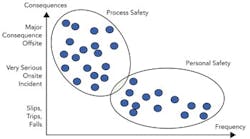Major accidents such as those at Texas City and Buncefield and in the Gulf of Mexico have highlighted the critical role played by senior managers in the process industries. Effective leadership is essential to develop a positive safety culture that remains constantly vigilant toward process safety risks. (For details on how DuPont and Dow executives have established a strong safety culture in their companies, see “Orchestrate An Effective Safety Culture,” and “Make Safety Second Nature,” ) The U.K. Health and Safety Executive (HSE) has made process safety leadership a key priority for high hazard industries.
This article will explore the leadership failings that contributed to recent major accidents and essential leadership principles, including:
• ensuring senior management actively supports process safety through its investment strategy and focus on the safety culture of the organization;
• reinforcing the importance of safety by personal example;
• thoroughly understanding major accident hazards and key risk control systems;
• investigating process safety incidents and near misses to find the underlying causes;
• developing world-class safety management systems; and
• identifying weaknesses in these systems using targeted performance indicators.
Investigation of the 2005 explosion at BP’s Texas City, Texas, refinery revealed a series of failings in process safety management (PSM). This prompted a fundamental and independent review of the BP corporate safety culture across its refining operations in the U.S. [1]. As the so-called Baker Panel emphasized, many of the deficiencies it found are not limited to BP. So, other processors certainly should ponder the following noteworthy comments in the report:
• Companies should regularly and thoroughly evaluate their safety culture and performance of their PSM systems.
• Preventing process accidents demands vigilance. People can forget to be afraid.
• BP has not provided effective process safety leadership and has not adequately established process safety as a core value.
• BP mistakenly interpreted improvement in personal injury rates as an indication of acceptable process safety performance.
• Process safety leadership appeared to have suffered as a result of high turnover of refinery plant managers.
• A good process safety culture requires a positive, trusting and open environment.
• BP does not have a designated high-ranking leader for process safety.
• The company did not always ensure that adequate resources were appropriately allocated to support or sustain a high level of process safety performance.
• BP has not demonstrated that it has effectively held executive management accountable for process safety performance.
• The panel found instances of lack of operating discipline, toleration of significant deviations from safe operating practices, and apparent complacency toward serious process safety risks.
In 2005, a massive explosion and fire at a fuel storage terminal in Buncefield, U.K., caused extensive damage. Several layers of protection failed, allowing a gasoline tank to overfill and ultimately resulting in a vapor cloud explosion. The HSE and a cross-industry group carried out a thorough investigation and highlighted leadership failings as a major contributor [2]:
• Management systems relating to tank filling were both deficient and not properly followed, despite having been independently audited.
• A lack of engineering support from head office worsened the pressure on staff.
• The culture made keeping the process operating the primary focus; process safety did not get the required attention, resources or priority.
• The operation lacked clear and positive process safety leadership with board-level involvement that should be at the core of managing a major hazard business.
• What was set out in the safety report and the safety management systems did not reflect what actually went on at the site.
• The management board did not effectively supervise major hazards; it apparently focused primarily on finances.
The U.K.’s Chemical Industries Association has summarized the behaviors expected for effective process safety leadership [4]:
• board champion for process safety, ensuring discussion at all board meetings to review performance and set future priorities;
• communication of process safety policy, stressing the importance set by the board and the role of people at all levels in protecting against major hazards;
• visibility of board-level management, e.g., visiting control rooms, making presentations on major hazard risks;
• use of effective leading and lagging process safety performance indicators (PSPIs) to allow board-level monitoring;
• board-endorsed formalized process safety improvements plan in place for ensuring continuous improvement; and
• outward-looking company and board with cross-industry approach to learning and sharing the lessons from incidents.
PRACTICAL APPROACH FOR IMPROVEMENT
A senior manager recognizing a poor process safety culture in the organization should take six steps, which are gleaned from experience gained across high-hazard industries:
Step 1. Understand the approach needed for process safety.
Many senior managers believe “safety” to be under control based on falling injury rates, only to be surprised by a serious fire, explosion or toxic release. Figure 1 can be used to explain to all staff the difference between personal safety and process safety.
Personal safety is related to relatively frequent low-severity events generally associated with the behaviors of individuals. This has been successfully managed in many companies by improved management focus and behavioral safety initiatives.
Process safety relates to serious events involving a loss of containment of hazardous chemicals or a release of energy. These events are rare and usually occur when several layers of protection have failed to prevent the escalation of an initial event. The causes are varied and involve both immediate failings and underlying systems’ shortcomings. Improving process safety performance requires an effective organization to maintain risk control systems and respond to any weaknesses identified.
Step 2. Implement best practice PSM systems.
The key elements of effective PSM systems are well defined in several publications and generally have converged between the U.S. and U.K. These elements have been identified following serious accidents in the process industries. For example, the explosion at Flixborough, U.K., in 1974, which stemmed from failure of a temporary pipe connection between two reactors, led to “management of change” being a key PSM element, with the requirement to carry out an assessment of the potential implications of any change.
The Energy Institute’s PSM framework [5] has 20 elements. Five relate to process safety leadership:
• leadership commitment and responsibility, including process safety policy and performance targets, plus structure and resources to achieve them;
• identification and compliance with regulatory and industry standards, to ensure the requirements of applicable legislation are identified, understood and satisfied;
• employee selection, placement, competency and health assurance, to make certain that current and new personnel can adequately handle their job responsibilities and are fit for work;
• workforce involvement, to align, involve and empower all staff in recognizing and managing process safety hazards; and
• communication with stakeholders, including identifying key stakeholders plus understanding and addressing their issues and concerns.
An effective PSM system should follow good practice requirements but must be tailored to reflect the organization and specific process safety hazards. A large manufacturing site that produces and distributes chlorine will have different procedures than a small facility storing flammable liquids. Senior managers should implement an independent review of the PSM system to identify and prioritize gaps and departures from relevant good practice.
Step 3. Understand process safety risks.
Facilities in the process industries face a number of specific major accident hazard scenarios depending upon the nature of the substances they handle and their processing activities. These are caused by known initiating events such as failure of hardware or control systems, or errors by operating or maintenance staff. Usually, plants rely on several layers of protection to prevent, control and mitigate these scenarios from escalating into a major accident, ensuring the risk has been reduced to an acceptable level.
Senior managers must thoroughly understand the main risk scenarios of the facilities they manage and remain constantly vigilant to complacency toward the risk control systems. The scenarios should be available in safety reports or similar documents such as hazard and operability reports. If this information is not available or is out of date, executives should initiate a thorough review of process safety hazards using competent specialists.
Step 4. Investigate process safety incidents.
Examinations of major accidents often reveal prior similar near misses that were not effectively followed up. An example of a process safety near miss is operation on demand of the high level trip on a flammable liquid storage tank. Although no harm has occurred, the potential exists for a serious fire or explosion if the same event happens and the high level trip fails to operate, as occurred in the Buncefield accident.
After incidents, senior managers should ensure the correct assessment of the potential for serious consequences. They should have a competent specialist perform thorough analyses of all process safety near misses. These investigations should assess the immediate causes plus any underlying ones involved. The aim should be to identify PSM system weaknesses that contributed to the incident because correcting these deficiencies will prevent similar incidents.
Step 5. Monitor process safety performance.
A key conclusion from the Texas City investigation [1] was “BP primarily used injury rates to measure process safety performance at its U.S. refineries before the Texas City accident.” This reinforced a similar conclusion following incidents at the BP Grangemouth, U.K., refinery in 2003 [6] and the need to develop key performance indicators for major hazards.
These reports have helped spur development of PSPIs to allow management of process safety at all levels up to the board room. The objective is to have appropriate leading (predictive) and lagging (failure) indicators that are reported and assessed in a manner similar to injury rates for personal safety.
Figure 2 shows a four-tier process safety pyramid based on an American Petroleum Institute recommended practice [7]. This reflects the principle that responding to more frequent and less severe incidents toward the base can control rare process safety accidents at the top of the pyramid.
The key challenge for an effective PSPI system is to identify appropriate and risk-targeted tier-4 leading indicators. These should be based on investigation of process safety incidents that have highlighted weaknesses in risk control systems. They also should be “SMART,” i.e.:
Sufficient — having enough data to trend changes;
Measurable — allowing efficient collection of data;
Accurate — providing data that is accepted as a true reflection;
Reliable — collecting data that the workforce values; and
Targeted — focusing on high risk systems.
Step 6. Carry out site visits.
Senior managers must provide “felt leadership.” As Judith Hackitt, chair of the HSE, stresses: “Process safety cannot be managed or led from the comfort of the boardroom.” It is important that executives are seen and people believe they are serious about process safety. Having set policies and declared the importance of process safety to the organization, senior managers should “walk the talk.” For example, leaders should challenge staff at a facility posing major hazards with questions such as:
• What was the last serious process safety incident and what has been done to prevent recurrence?
• What safety systems are out of service or overridden?
• What safety-critical equipment inspections or proof tests are overdue?
• What equipment is running outside of design limits or inspection recommendations?
• What is the biggest process safety risk on site? Can you show me why the process is safe?
• What measures can you show me that verify proper management of process safety?
• What independent assessment have you had to show you’re managing process safety properly?
• Show me how you have learned from a recent major incident outside of the company.
• Show me how you manage process safety competence.
• How many safety systems have activated recently? Why and what have you done about this?
• Have you had any process safety incidents that human intervention prevented from becoming worse?
• What process safety experience and expertise do you have on site?
LEADERSHIP MATTERS
Senior managers must remain constantly vigilant to the risk of a major accident at their facilities. The lack of a previous incident is no guarantee that one could not happen tomorrow, so it is essential to monitor process safety performance and respond to warning signals.
Executives should critically review the key leadership principles outlined in this article to check that they are doing all that can be reasonably expected. They should treat this as a matter of urgency, to pre-empt the soul searching that would follow a serious accident at one of their facilities.
Senior managers also should take the six key steps cited to improve process safety performance. I believe that ensuring a strong response to near misses is the most important of these. Leaders should require a thorough investigation of near misses, to find weaknesses in the overall process safety risk control systems and learnings that can be used to implement focused improvements.
GRAEME ELLIS is principal lead consultant for ABB Consulting, Warrington, UK. E-mail him at [email protected].
REFERENCES
1. Baker, J. et al., “The Report of the BP U.S. Refineries Independent Safety Review Panel,” BP, London (2007).
2. “Buncefield: Why Did It Happen? The Underlying Causes of the Explosion and Fire at the Buncefield Oil Storage Depot, Hemel Hempstead, Hertfordshire On 11 December 2005,” HSE Books, Sudbury, U.K. (2011).
3. Schein, E. H., “Organizational Culture and Leadership,” 4 ed., John Wiley, Hoboken, N.J. (2010).
4. “Best Practice Guide: Process Safety Leadership in the Chemicals Industry,” Chemical Industries Assn., London (2008).
5. “High Level Framework for Process Safety Management,” Energy Institute, London (2010).
6. “Major Incident Investigation Report, BP Grangemouth Scotland, 29th May – 10th June 2000,” HMSO, Norwich, U.K. (2003).
7. “Process Safety Performance Indicators for the Refining and Petrochemical Industries, Recommended Practice 754,” American Petroleum Institute, Washington, D.C. (2010).




